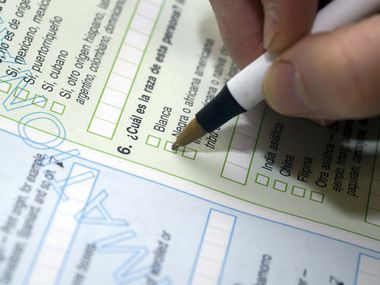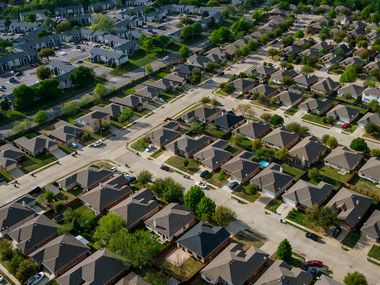WASHINGTON – Texas is poised to add two House seats – and perhaps even three – to its already massive congressional delegation in the wake of the 2020 census, according to the latest population estimates released this week by the U.S. Census Bureau.
Those projections track longstanding expectations for fast-growing Texas, whose population now stands just shy of 29 million people.
But the final estimates ahead of next year’s official decennial count underscore the high stakes of reapportionment, the process that will set off contentious – and highly political – battles in the Lone Star State and elsewhere to remake the congressional map.
The outcome also holds significant implications beyond just partisanship, though the looming redistricting fight in the state Legislature is a focal point for both Democrats and Republicans.
Billions of dollars in federal funding – covering high-profile programs like the Children’s Health Insurance Program – are allocated each year based on census data. A population under-count in Texas of just 1% could cost the state at least $300 million annually, according to one study.
That means actual participation in the 2020 census is crucial to ensuring an accurate count.
Some experts worry that Texas is ill-positioned to maximize its tally. Michael Li, a Texan who’s a redistricting counsel at the Brennan Center for Justice in New York, noted the disparity in how Texas is approaching next year’s census, as compared to other states.
“Some states are spending a lot to encourage participation,” he wrote on Twitter, pointing out that California and New York are each devoting more than $100 million to the task. “States like Texas are spending $0.”
Texas’ growth is part of a broader demographic trend across the U.S.
States in the South and Southwest continue to see moving trucks arrive. Other big winners in the latest population estimates include Florida, North Carolina and Colorado. States in the North and Midwest keep shedding residents. Losers include New York, Illinois and Pennsylvania.
The gains have generally come in GOP-run states and the losses in Democratic-run ones, providing ample fodder for Republicans in Texas and beyond.
Texas’ conservative leaders have argued for years that the state’s business-friendly climate and relatively low-tax policies have helped drive growth, attracting major corporations like Toyota, who recently moved its North American headquarters to Plano from California.
Consider also California, a Democratic oasis that’s one of Texas’ domestic economic rivals. It is now, for the first time ever, among the states projected to see one of their House seats disappear.
“There is no more attractive feature that you can offer people than job opportunities and low taxes,” said Bill Miller, an Austin-based GOP consultant who added, only half-jokingly, that air conditioning also continues to be a key component in Texas’ growth.
Democrats counter that the picture is more complex.
The Lone Star State is home to a fast-growing Latino population, which tends to vote Democratic. Much of the population growth in Texas is also centered on major metropolitan areas like Dallas-Fort Worth, Houston and Austin – traditional Democratic strongholds.
Those trends have helped set the stage for an epic 2020 election clash.
Democrats are predicting that they will fulfill a longstanding pledge to turn Texas blue after decades of GOP dominance. The state, at the least, has emerged as a high-dollar battleground, with a number of contested races cropping up at the federal and state level.
Those battles, in turn, will help determine the next political map.
The census count – and any subsequent reapportionment – is not directly tied to the 2020 election. But the Legislature in Texas is tasked with redistricting, meaning that the re-mapping could vary wildly based on whether Democrats can win control of say, the state House.
“A huge amount is at stake,” said Matt Angle of the Lone Star Project, a Democratic political action committee that’s among the groups looking to help flip GOP seats up and down the ballot.
Texas is no stranger to bitter redistricting fights.
The state gained four U.S. House seats after the 2010 census – bringing its total to 36, with 23 districts now represented by Republicans and 13 by Democrats. But Republicans’ attempts at doling out those districts drew scrutiny for gerrymandering, leading to a protracted legal battle.
The process this time around is also sure to be hotly debated.
But first there must be the count itself. Estimates provided this week by the U.S. Census Bureau offer perhaps the best prediction of how the decennial tally will end up, given that there’s now less than a year until the census actually begins.
Demographers can also use the new data to project reapportionment. Based on just the 2019 population estimates, Texas would pick up two House seats, according to an analysis by Election Data Services, a Virginia firm that specializes in redistricting.
But accounting for continued growth in the coming months, Texas stands to gain an additional seat, the group found. That would make Texas the only state in the U.S. to add three House seats – and, accordingly, three Electoral College votes, per Election Data Services.
It remains to be seen, however, if the official count in Texas matches those estimates.
Some worry about the ability to get an accurate tally of the state’s Latino population and other groups that tend to be under-counted. That concern was exacerbated by President Donald Trump’s failed attempt to include a citizenship question on the census.
Angle, the Democratic operative, also said it was “inexcusable” that Texas’ GOP leaders didn’t follow California and other states in devoting money, much less substantial amounts, to aid the census count.
Many cities and counties in Texas have teamed with philanthropic groups to take on the task, though those efforts have focused on metropolitan areas. Dallas County Judge Clay Jenkins, for instance, said earlier this year that the county and city planned to spend upwards of $2.5 million on the census.
Miller, the GOP consultant, agreed that money devoted to ensuring a complete count was well-spent.
“You want to strengthen your numbers,” he said. “If we’re casual, in the purest sense of the word, we’re going to be under-counted, vis-à-vis others. And that’s not a smart move.”


